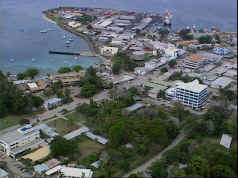Honiara, Solomon Islands
| Honiara | ||
|---|---|---|

Honiara
|
||
|
||
| Coordinates: 9°25′55″S 159°57′20″E / 9.43194°S 159.95556°ECoordinates: 9°25′55″S 159°57′20″E / 9.43194°S 159.95556°E | ||
| Country |
|
|
| Province | Honiara Town | |
| Island | Guadalcanal | |
| Government | ||
| • Mayor | Israel Maeoli | |
| Area | ||
| • Total | 22 km2 (8 sq mi) | |
| Elevation | 29 m (95 ft) | |
| Population (2017) | ||
| • Total | 84,520 | |
| • Density | 3,800/km2 (10,000/sq mi) | |
| Time zone | UTC (UTC+11) | |
| Climate | Af | |
Honiara /ˌhoʊnɪˈɑːrə/ is the capital city of the Solomon Islands, situated on the northwestern coast of Guadalcanal. As of 2017[update] it had a population of 84,520 people. The city is served by Honiara International Airport and the sea port of Point Cruz, and lies along the Kukum Highway.
The airport area to the east of Honiara was the site of a battle between the United States and the Japanese during the Guadalcanal Campaign in World War II, the Battle of Henderson Field of 1942, from which America emerged victorious. After Honiara became the new administrative centre of the British Solomon Islands Protectorate in 1952 with the addition of many administrative buildings, the town began to develop and grow in population. Since the late 1990s, Honiara has suffered a turbulent history of ethnic violence and political unrest and is scarred by rioting. A coup attempt in June 2000 resulted in violent rebellions and fighting between the ethnic Malaitans of the Malaita Eagle Force (MEF) and the Guadalcanal natives of the Isatabu Freedom Movement (IFM).
Although a peace agreement was made in October 2000, violence ensued in the city streets in March 2002 when two diplomats from New Zealand and numerous others were murdered. In July 2003, conditions had become so bad in Honiara that the Regional Assistance Mission to Solomon Islands (RAMSI), consisting of multiple Pacific nations under Australian leadership, was invited into the country by the Solomons Government to restore order. In 2006, riots broke out following the election of Snyder Rini as Prime Minister, destroying a part of Chinatown and making more than 1,000 Chinese residents homeless. The riots devastated the town and tourism in the city and the islands was severely affected.
...
Wikipedia


